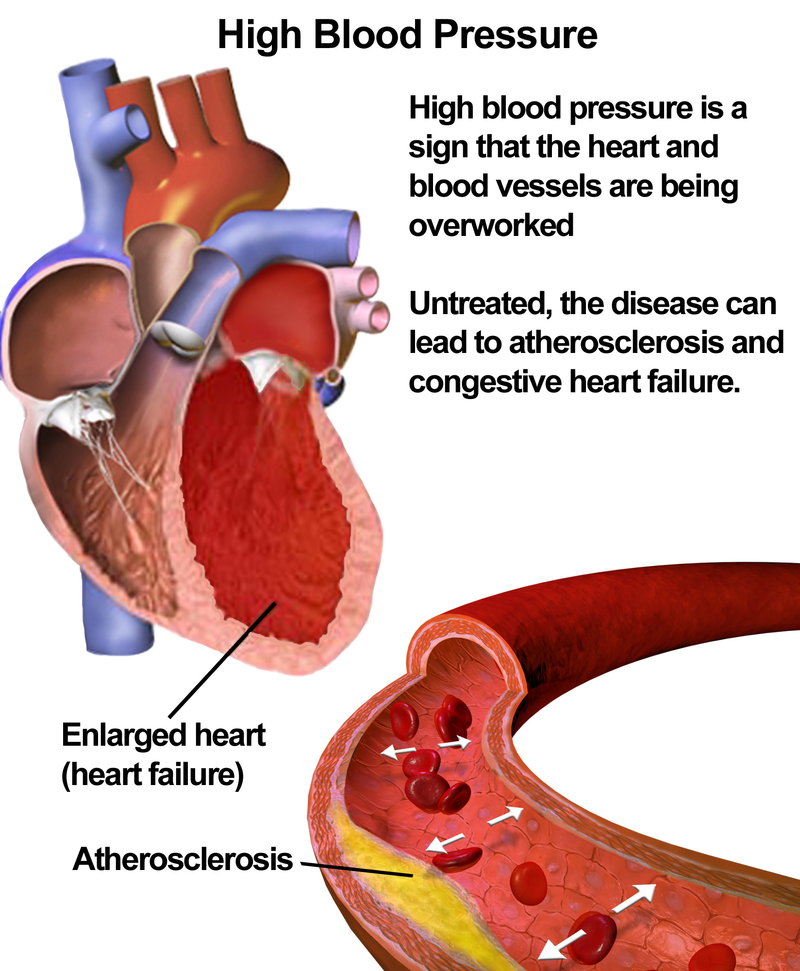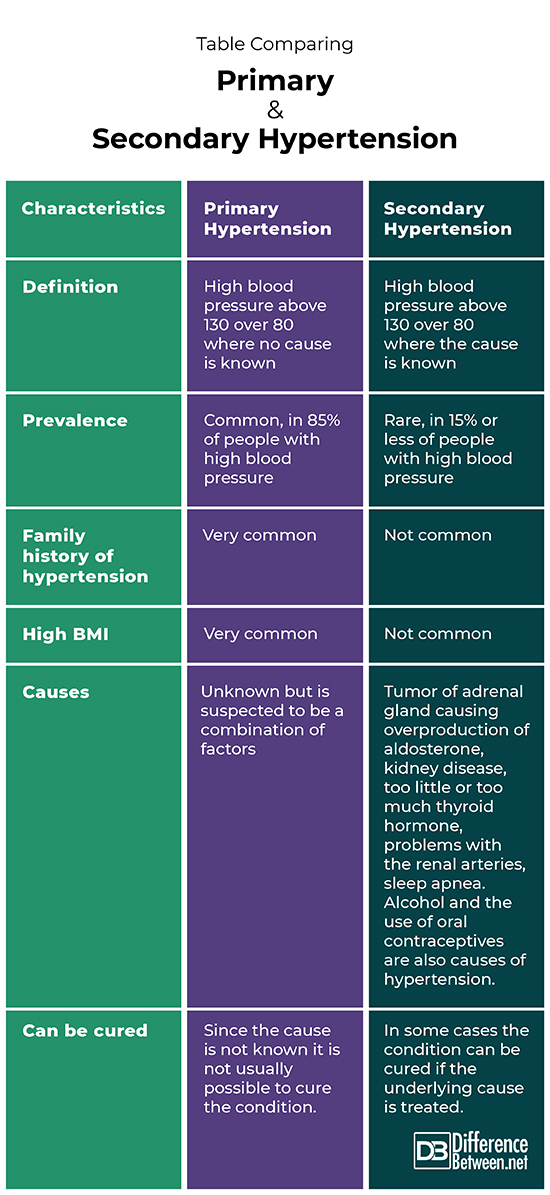Difference Between Primary and Secondary Hypertension
Primary hypertension is abnormally high blood pressure of greater than 130 over 80 where the cause is not known. Secondary hypertension is also unusually high blood pressure but it is where the cause of the condition is known.
What is Primary Hypertension?
Definition:
Primary hypertension is also known as idiopathic hypertension and it is high blood pressure of greater than 130 systolic and 80 diastolic for which a cause is not known.
Symptoms and prevention:
In some cases, there may not be noticeable symptoms. In other cases, people may have severe headaches, vision problems and feel dizzy. Noticeable symptoms may only appear at dangerously high blood pressure levels. Since the cause is not known it is hard for people to prevent getting primary hypertension.
Diagnosis and causes:
The hypertension is noted when a blood pressure reading is taken using a sphygmomanometer and a high reading is noted from two to three readings. The cause of high blood pressure in the case of primary hypertension is not known but individuals usually have a family history of hypertension.
Risk factors:
Having a family history of hypertension seems to be a risk factor as studies among hypertensive children have shown a higher number of cases occurring where there is a family member who had high blood pressure. Scientists have also found that children with a high body mass index are more prone to having primary hypertension than secondary hypertension. Obesity, a high salt intake and genetics are all suspected risk factors for essential hypertension.
Treatment:
Treatment usually involves taking medication to lower the blood pressure and implementing lifestyle changes such as reducing salt intake and exercising.
What is Secondary Hypertension?
Definition:
Secondary hypertension is high blood pressure of higher than 130 over 80 for which there is a known cause.
Symptoms and prevention:
The symptoms may not be evident until the hypertension is very severe. Such symptoms may include blurry vision, a feeling of unsteadiness and dizzy sensation and a bad headache. Secondary hypertension may be prevented if people can control the medical problems that cause the high blood pressure.
Diagnosis and causes:
The condition of secondary hypertension is diagnosed by using a blood pressure cuff (sphygmomanometer), and recording a high value from more than one reading of the blood pressure. There are several known causes of secondary hypertension including vascular problems of the renal arteries and kidney disease. The overproduction of aldosterone due to adrenal tumors is also a cause as are problems of the thyroid gland in which too much or too few hormones are released. Excess alcohol intake and taking oral contraceptives can also lead to secondary hypertension.
Risk factors:
Problems with aldosterone, the thyroid gland and kidneys are risk factors for secondary hypertension. Taking oral contraceptives and drinking alcohol also increases the risk.
Treatment:
Patients can be treated with blood pressure medication and in some cases if the underlying disease causing the condition is treated, the problem can be fixed. For instance, if oral contraceptives are causing the problem then the person can stop taking this and may be cured of the condition.
Difference between Primary and Secondary Hypertension?
Definition
Primary hypertension is high blood pressure where the cause is not known. Secondary hypertension is high blood pressure where the cause is known, where it is the result of another medical problem.
Prevalence
The primary hypertension is very common with about 85% of hypertension cases classified as primary. The secondary hypertension is much less common with 15% or less of cases due to secondary causes.
Family history of hypertension
Having a family history of high blood pressure is common among patients who have primary hypertension. Having a family history of high blood pressure is rare among patients who have secondary hypertension.
High BMI
Having a high body mass index (BMI) is commonly seen in patients with primary hypertension. Having a high body mass index is not common in patients who have secondary hypertension.
Causes
The cause of primary hypertension is not known. The cause of secondary hypertension is known and is due to another condition such as kidney disease, a tumor of the adrenal gland causing overproduction of aldosterone, too little or too much thyroid hormone, problems with the renal arteries, sleep apnea, and use of oral contraceptives or excess alcohol intake.
Can be cured
Since the cause of primary hypertension is not known it is unlikely to be completely cured. In some cases because the cause of secondary hypertension is known it is possible to cure the condition if the underlying medical problem can be fixed.
Table Comparing Primary and Secondary Hypertension
Summary of Primary Vs. Secondary Hypertension
- Primary and secondary hypertension are both conditions in which a person’s blood pressure is excessively high, above 130 systolic and 80 diastolic.
- Hypertension, in general, is diagnosed based on blood pressure readings that are taken a few times and noted to be very high each time.
- The cause of primary hypertension is not known but people who have a family history or who are obese seem to have a higher risk of the condition.
- The cause of secondary hypertension is known and can be the result of several diseases including kidney problems and hormone issues.
- Difference Between Rumination and Regurgitation - June 13, 2024
- Difference Between Pyelectasis and Hydronephrosis - June 4, 2024
- Difference Between Cellulitis and Erysipelas - June 1, 2024
Search DifferenceBetween.net :
Leave a Response
References :
[0]Bakris, George L. “Overview of hypertension.” Merckmanuals. Merck & Co., 2018, https://www.msdmanuals.com/professional/cardiovascular-disorders/hypertension/overview-of-hypertension/
[1]Baracco, Rossana, et al. "Prediction of primary vs secondary hypertension in children." The Journal of Clinical Hypertension 14.5 (2012): 316-321.
[2]Gupta-Malhotra, Monesha, et al. "Essential hypertension vs. secondary hypertension among children." American journal of hypertension 28.1 (2014): 73-80.
[3]Image credit: https://commons.wikimedia.org/wiki/File:Primary_secondary_ratio.png
[4]Image credit: https://commons.wikimedia.org/wiki/File:Hypertension_types.png


